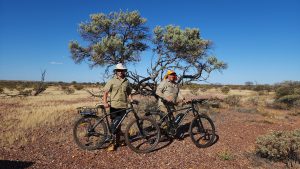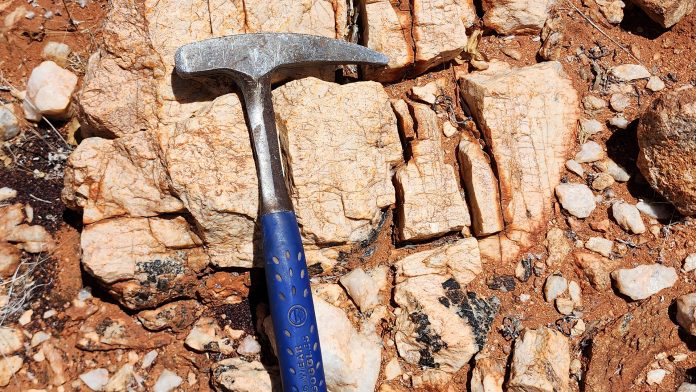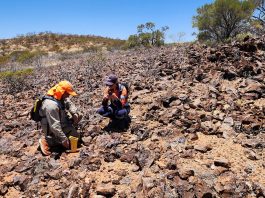Voltaic Strategic Resources outlines how a lithium discovery in the Gascoyne region of Western Australia will meet the demand for lithium resources and aid the global energy transition.
The global energy transition from hydrocarbons to renewables has reached critical momentum. It is inevitable that there will be a transformation of the energy supply, storage, and transmission story over the next few decades. Lithium will play a crucial role in the storage component of energy in this revolution.
The journey of Voltaic Strategic Resources Ltd mirrors this transition. It has transformed from being an oil and gas exploration and production company to divesting this business and focusing its capital and resources on the exploration for battery minerals which are critical for the green energy transition.
In 2018, Voltaic recognised that there was a structural shift to reducing the reliance on oil and gas and fuelling a global energy transition. It started to diversify with the pegging of multiple exploration lode claims in Nevada, USA, which were prospective for Cobalt. In 2021, the company made a decision to divest its remaining hydrocarbon assets and invested in prospective mineral exploration tenements in Western Australia. The company’s focus was to identify mineral exploration licenses that were prospective for battery metals, including lithium, cobalt, nickel, copper and rare earth elements (REEs).
In 2022, Voltaic completed the acquisition of a number of exploration licenses located in the Gascoyne Region of Western Australia, which had been secured due to their potential to discover the critical minerals that Voltaic was targeting.
Mineral exploration, by its very nature, is a risky business and success is never guaranteed. Making a successful mineral discovery can be enhanced if the exploration is carried out in the right geological environment and the programmes are planned and undertaken by skilled and experienced people.
Creating the team
Voltaic set about recruiting a high-quality management team to advance the global energy transition. It secured the services of two highly qualified and experienced individuals in the roles of Chief Executive Officer and Exploration Manager.
Michael Walshe was employed as Voltaic’s CEO in 2022. Michael is an experienced Chemical Engineer and has spent the previous 15 years in engineering, operations, technology commercialisation, and project development roles across the minerals, chemicals, and renewable energy sectors.
He has worked across a wide range of commodities, including lithium, rare earths, nickel, copper, zinc, and gold. He has extensive experience in advising on metallurgy and process design for some of the largest lithium extraction projects in Australia and SE Asia.
Claudio Sheriff was recruited as the Company’s exploration manager. He is a highly experienced geologist who has been involved in the discovery of multiple REE resources. Claudio has expertise in mineralised systems throughout Australia, Indonesia, and Chile. These include target generation, systematic ranking of prospects, and exploration and discovery through resource drill-out across a wide range of deposit types.
The combination of a Chemical Engineer who understands what characteristics that are required for a lithium resource to be successfully commercialised and a skilled and experienced Geologist who understands what geological characteristics are required to improve the likelihood of a successful lithium discovery has created a strong management team.
The leadership team is focused on discovering a lithium resource as quickly as possible while remaining conscious of the finite capital resources that the Company has to achieve this objective.
Science-driven lithium exploration
The science of mineral discovery and extraction in relation to a lot of the more commonly mined minerals such as gold, nickel, and uranium is well understood. However, the discovery of lithium deposits in Western Australia is less established.
The world’s largest hard-rock lithium mine is Greenbushes, which is located in Western Australia. This mine started out as a tin mine in 1888 and remained focused on the mining of tin and tantalum until the late 1970s. When lithium was identified in tailings (waste) from previous mining operations, it was extracted as the primary product from the mine.
There have subsequently been a number of world-class lithium discoveries in Western Australia that will fuel the global energy transition. These include Mount Marion (Kalgoorlie), Pilgangoora (Pilbara Region), Mt Catlin (Ravensthorpe), Wodgina (Pilbara Region) and Mt Holland (Forrestania Region). All of these discoveries have different characteristics, which necessitates a more localised understanding of geology to interpret the potential for lithium to be present in the host rocks.
Following Voltaic’s acquisition of the Gascoyne tenements, the management team began identifying every bit of historical exploration data that they could gather. They spent considerable time on the ground carrying out field reconnaissance to understand the terrain and collect surface rock chip and soil samples with a small team of field technicians. They searched historical records of the limited exploration that had been undertaken on and around the company’s Gascoyne tenements.
There have been some successful drilling results on adjacent exploration licenses, which resulted in the discovery by Arrow Minerals of the Malinda Lithium prospect, now called Yinnetharra and owned by Delta Lithium Ltd. The Voltaic team focused their attention on the potential of there being other lithium resources associated with Yinnetharra to advance the global energy transition.
The exploration strategy for the discovery of lithium is reliant upon overlaying multiple sources of data to build up a model that will lead to a suite of high-value prospects for drilling. Voltaic continues to expand its knowledge with various geophysical methods to detect subsurface geological structures and lithologies associated with lithium deposits. Techniques like magnetic surveys and electrical resistivity surveys help identify potential lithium-rich zones based on their distinct physical properties. Satellite imagery and aerial surveys are being used to identify surface features associated with lithium deposits.
Lithium, by its very nature, is a very mobile element. However, it is often identified through the discovery of pathfinder elements such as caesium, tantalum and tin which are more likely to be present in the absence of lithium in more weathered rock/soil samples.
Voltaic has commenced geochemical analysis of rock chip and soil samples to determine their lithium content. It also uses various techniques, such as portable X-ray fluorescence (XRF) spectrometry and handheld LIBS (laser-induced breakdown spectroscopy) analysis, to estimate the lithium concentration in the collected samples. Anomalous lithium values in surface samples may indicate the presence of lithium mineralisation in sub-surface rocks.
Ultimately, drilling to collect samples of rocks from below the surface is required to provide definitive evidence of lithium being present. Core drilling or rotary drilling techniques are being employed to collect representative samples from the target areas. These samples will be analysed for lithium content, mineralogy, and other relevant parameters to assess the economic viability of the deposit and whether these samples are useful for the global energy transition.
Why look for lithium in the Gascoyne?
Western Australia has a long history of successful mineral exploration and mining, which started with the gold discoveries in the Kimberley and Kalgoorlie regions in the late 1800s. The Gascoyne region did not have a lot of historical mineral exploration due to the lack of infrastructure and difficult access. Moreover, it was a historical anomaly, as there was no government gold battery built in the area during the early gold rush period, as there had been in many other locations around Western Australia.

As a result, there was less early exploration and mining carried out in the Gascoyne, and the discovery of mineral resources of significant economic scale in this region has been a more recent phenomenon.
Part of the success of a junior exploration company relies to some extent upon the good fortune of having exploration tenements that are in the right location.
The Gascoyne region possesses geological formations that are favourable for lithium mineralisation.
Lithium is typically found in pegmatite deposits, which are coarse-grained igneous rocks. The Gascoyne region hosts various types of pegmatite systems, including spodumene-bearing pegmatites, which are a significant source of lithium.
The ground surveys that have been carried out by Voltaic have identified extensive outcropping pegmatite formations over wide areas. The mere presence of pegmatites does not guarantee that there will be spodumene (which contains lithium). However, it is part of the geological environment that could host lithium and is, therefore, a positive indicator for ongoing exploration.
Pegmatites are intrusive igneous rocks that are characterised by their large crystal size and can contain a variety of minerals, including valuable ones like caesium, lithium, tantalum, and tin. The formation of pegmatites is often associated with the cooling and crystallisation of magma deep within the Earth’s crust. The Gascoyne region has a complex geological history involving tectonic processes, including the collision and separation of continents over millions of years. These processes can create favourable conditions for the formation of pegmatites. Lithium is typically found in pegmatite deposits.
It is often stated in the business of mineral exploration that “the best place to look for a new resource is near an existing mine or resource.”
Rock formations that have led to the discovery of a minable mineral resource will often extend beyond where the first discovery has been made. With this in mind, Voltaic has the good fortune that the early stages of an extensive lithium discovery have been made on tenements that are adjacent to its exploration licenses.
Arrow Minerals Ltd (previously Segue Resources Ltd) commenced exploration at its Gascoyne project in 2016-2017, which led to the discovery of the Malinda Lithium prospect. The Malinda Project (later referred to as Yinnetharra Lithium Project) was subsequently acquired by ASX-listed company Delta Lithium Ltd (previously called Red Dirt Metals Ltd) in 2022.
Delta Lithium has committed to a significant drilling programme at the Yinnethara Project. Information and results from the drilling program are periodically announced by Delta Lithium via ASX announcements which are publicly available. This information assists Voltaic with its understanding of the local geology in relation to the potential discovery of lithium-bearing minerals.
Lithium is vital for the global energy transition
While lithium itself is not rare, economically viable lithium deposits that can be readily extracted and processed at a reasonable cost are more limited.
The majority of lithium production comes from a few countries, including Australia, Chile, and Argentina, which have significant lithium reserves. The demand for lithium has increased significantly in recent years due to its use in the global energy transition and the growing popularity of EVs and renewable energy storage systems. This has led to concerns about the future availability of sufficient lithium resources.
Efforts are underway to explore and develop new lithium deposits and improve lithium extraction technologies to meet the rising demand and fuel the global energy transition. The work that Voltaic is undertaking in relation to its lithium exploration is a small but important piece of this global puzzle.
The world’s growing need for lithium primarily stems from its crucial role in the storage of energy that comes from the development of renewable energy technologies and the increasing demand for electric vehicles (EVs). The transition away from traditional base-load power supplies such as coal and gas will not be possible without a significant increase in the amount of energy storage (batteries) that is available.
Lithium-ion batteries have become the leading energy storage technology due to their high energy density, long cycle life, and lightweight nature. As the transition to renewable energy sources like solar and wind accelerates, efficient energy storage becomes essential for balancing intermittent power generation, smoothing out grid fluctuations, and providing electricity during peak demand.
Lithium is an important component in the manufacture of battery storage for several reasons:
- High Energy Density;
- Lightweight;
- Rechargeability;
- High Voltage; and
- Low Self-Discharge.
Lithium-ion batteries are playing a big part in the global energy transition. They store excess electricity generated during periods of high renewable energy production and discharge it when demand exceeds supply. This helps stabilise the grid, reduce reliance on traditional fossil fuel power plants, and increase the overall share of renewable energy in the energy mix.
Voltaic’s commitment to sustainable practices
Voltaic is committed to carrying out its exploration sustainably. Exploration activities co-exist with other land users, such as livestock businesses which have used these lands for nearly 150 years.
There is recognition that First Nations people have been present in these parts of Australia for tens of thousands of years. Before any drilling campaigns commence, Voltaic engages with local First Nations elders to carry out surveys to ensure that no areas of cultural or heritage significance are being disturbed. Consideration is given to planning drilling programmes that cause minimal interference with flora, especially in relation to species that are categorised as endangered. Rehabilitation of drilling pads and tracks is carried out after a campaign is completed.
Voltaic has experimented with the use of e-bikes as a means of field transport during sample collection to create a smaller carbon footprint and impact on the environment. The company has trialled drill rigs that have a lower fuel consumption and less environmental impact through ground disturbance.
These initiatives are practical steps that Voltaic is taking to ensure that its exploration activities are as sustainable as possible.
What’s next for Voltaic?
Although Voltaic is a relatively small player in the sea of lithium explorers and developers, it has staked a claim to making an important and potentially substantial contribution to being a future supplier of lithium, an essential ingredient required for the transition to a cleaner environment.
There is still a long way to go before the company can claim to have made a commercial lithium discovery. However, it has laid the foundations and has the skills and resources to bring this to fruition.
The development of a commercial lithium resource will ultimately require significant capital and expertise that may be beyond Voltaic’s current capacity. However, the discovery of a lithium resource is well within its capabilities.








